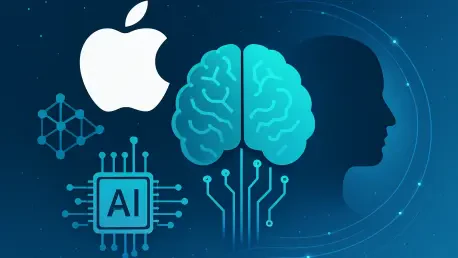In 2025, Apple stands at the forefront of a rapidly evolving artificial intelligence (AI) market, commanding attention with its Apple Intelligence platform as global spending on AI technologies surpasses $300 billion annually. This staggering figure underscores the high stakes of a sector where innovation dictates market leadership, and Apple’s strategic maneuvers are shaping the trajectory of consumer tech. This market analysis delves into how Apple is leveraging partnerships, proprietary developments, and a steadfast commitment to privacy to carve out a dominant position. The purpose of this examination is to uncover the trends driving Apple’s AI strategy, assess its current market impact, and forecast its potential to redefine industry standards. By exploring these dynamics, a clearer picture emerges of how Apple is not merely participating but actively steering the future of AI integration in everyday technology.
Decoding Market Trends: Apple’s Dual Approach to AI Innovation
Strategic Alliances: Harnessing OpenAI’s GPT-5 for Market Edge
Apple’s collaboration with OpenAI, particularly the integration of the GPT-5 model into the iOS 26 series across iPhones, iPads, and Macs, marks a pivotal trend in the AI market. This advanced model, known for superior reasoning capabilities, accelerated response times, and minimized errors, positions Apple to deliver unparalleled user experiences in a competitive landscape where immediacy and accuracy are paramount. The partnership builds on the privacy-focused integration of ChatGPT 4o, ensuring user data remains protected through masked IP addresses and non-storage policies by OpenAI. This move reflects a broader industry shift toward collaborative innovation, where tech giants tap external expertise to enhance their ecosystems while addressing consumer concerns about data security. However, reliance on third-party models introduces risks, such as potential misalignments in privacy protocols or dependency on external timelines, which could impact Apple’s market agility.
Proprietary Powerhouse: Apple’s In-House AI Developments
Parallel to its external partnerships, Apple is aggressively pursuing internal AI solutions, a trend indicative of a market increasingly valuing customized technology. Features like a more personalized Siri, Live Translation, and Visual Intelligence enhancements, rolled out in the current year, demonstrate Apple’s focus on context-aware, task-specific tools tailored to user needs. Additionally, niche projects such as a generative AI support assistant for the Apple Support app and a web-crawling “Answers engine” for Siri, Spotlight, and Safari highlight a strategic pivot toward ecosystem-specific innovation. Unlike competitors chasing expansive, generalized AI models, Apple’s approach prioritizes depth, potentially strengthening customer loyalty but risking slower penetration into broader AI applications. This balance of specialization versus scale is a defining tension in today’s AI market, with Apple betting on integration as a key differentiator.
Investment and Expansion: Mergers, Acquisitions, and Talent Dynamics
Apple’s strategic vision extends to market expansion through mergers and acquisitions (M&A), reflecting an industry trend where inorganic growth supplements organic innovation. The company’s leadership has signaled openness to acquiring firms ranging from established AI players like Perplexity to specialized innovators such as Runway AI and Eleven Labs, aiming to rapidly fill capability gaps. Yet, a significant market challenge lies in talent retention, as aggressive poaching by competitors threatens the long-term value of these acquisitions. Industry analysis suggests that Apple must couple M&A with robust cultural integration to sustain innovation momentum, a factor critical in a market where human capital drives technological breakthroughs. This dual focus on strategic acquisitions and talent management underscores Apple’s pragmatic approach to maintaining a competitive edge amidst fierce rivalry.
Market Projections: Apple’s AI Trajectory and Industry Impact
Looking ahead, Apple is well-positioned to capitalize on emerging AI trends that could reshape market dynamics over the next few years, from 2025 to 2027. The deeper integration of advanced models like GPT-5 indicates a future where Apple Intelligence handles complex, real-time tasks, potentially expanding into creative content generation and advanced problem-solving, areas projected to grow by 25% annually in consumer tech. Simultaneously, the emphasis on proprietary tools suggests a gradual shift toward reduced reliance on external partnerships, mitigating privacy and dependency risks while strengthening brand autonomy—a move that could redefine trust in AI applications. Economic indicators, such as Apple’s escalating R&D investments, estimated to reach $30 billion by 2027, signal sustained commitment to innovation despite regulatory pressures around data practices looming large.
Another critical projection centers on Apple’s potential to dominate niche AI segments within its ecosystem, a market expected to see a compound annual growth rate of 18% through 2027. By focusing on user-centric, privacy-first solutions, Apple could set new benchmarks for personalized technology, especially if strategic acquisitions yield cutting-edge capabilities. However, the pace of market entry remains a variable, as Apple’s deliberate strategy of prioritizing quality over speed may cede short-term gains to faster-moving competitors. Analysts anticipate that Apple’s patient approach could solidify its leadership in high-value, specialized AI applications, particularly if it navigates talent competition and regulatory landscapes effectively.
Geopolitical and economic factors also play into Apple’s AI market outlook, with supply chain stability and global privacy laws influencing deployment timelines. As consumer demand for secure, integrated AI solutions surges—projected to account for 40% of tech spending by 2027—Apple’s historical emphasis on ecosystem cohesion and data protection emerges as a significant market advantage. The company’s ability to balance innovation with compliance will likely determine its share in a market increasingly defined by user trust. These projections collectively paint a picture of Apple as a calculated player, poised to leverage both technological and strategic strengths to sustain long-term growth in a crowded field.
Reflecting on Apple’s AI Journey: Strategic Insights for the Road Ahead
Looking back, Apple’s journey in AI during 2025 revealed a calculated blend of strategic partnerships and internal innovation that solidified its standing in a competitive market. The integration of OpenAI’s GPT-5 model marked a significant milestone in enhancing user experiences, while proprietary developments like an evolved Siri underscored a commitment to tailored solutions. Strategic openness to mergers and acquisitions, despite challenges in talent retention, further highlighted Apple’s adaptability in a dynamic industry.
For stakeholders, the next steps involve closely monitoring Apple’s rollout of AI enhancements and privacy policies to anticipate shifts in consumer expectations. Businesses and developers are encouraged to explore opportunities within Apple’s tightening ecosystem, potentially creating apps and services aligned with its user-focused tools. Meanwhile, investors need to weigh the long-term benefits of Apple’s patient innovation strategy against short-term competitive pressures. Ultimately, staying attuned to Apple’s balance of external collaboration and internal growth offers the best path to navigating the evolving AI landscape, ensuring readiness for the transformative changes that lie ahead.









